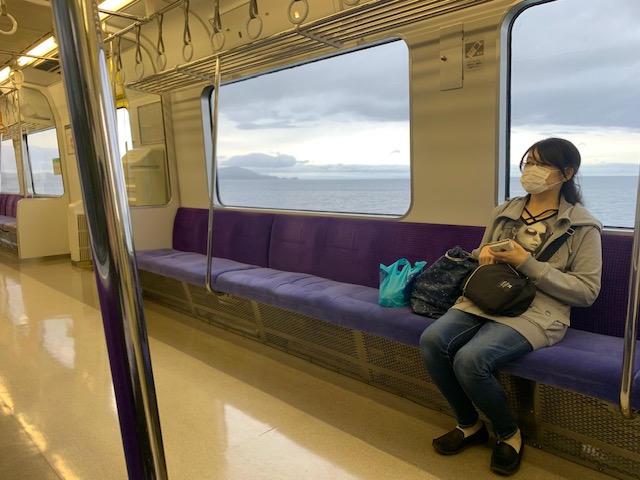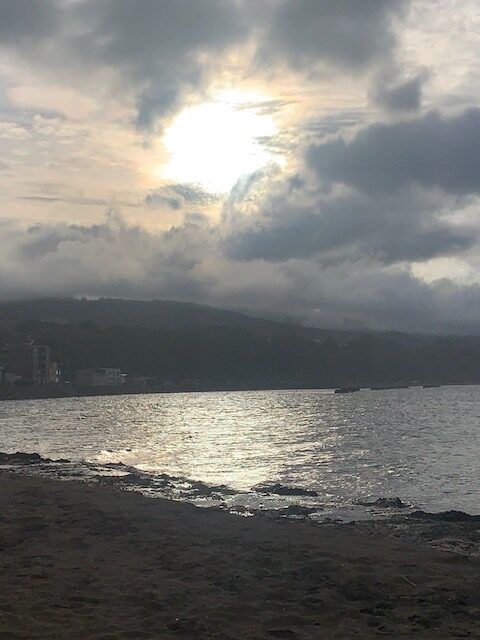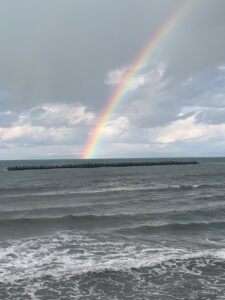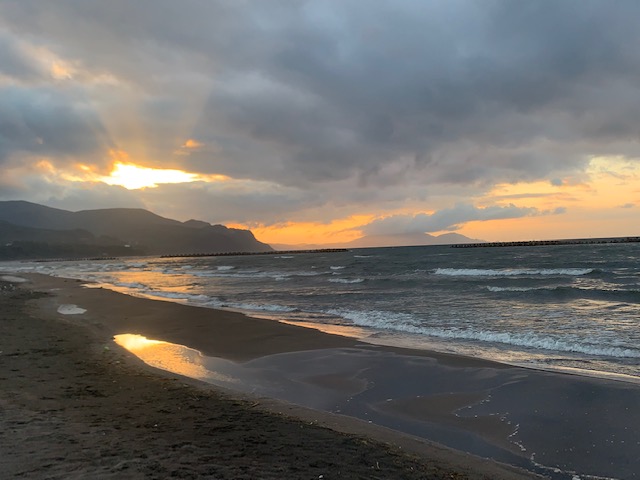The seaside town of Otaru is just half an hour from Sapporo. It’s said to be exotic – exotic for Japan that is, which means it has historical Western-style buildings. The train runs along the coast as it nears the town, with views of picturesque outcroppings on which sit clusters of cormorants and seagulls, sometimes socially distanced but sometimes in mixed groups of black and white. The sea is gentle here, and makeshift houses are squeezed improbably into the narrow space between tracks and beach. ‘Beware Tsunami’ said a curt sign, with no explanation as to how.
Otaru burst into view as we rounded a bend, set in a bay with buildings ascending the nearby hills. It is a city of slopes, some of them steep, though the name which derives from Ainu means ‘river running through a sandy beach’. Fifteen taxis waiting patiently at the station told of a busy little town , and colour brochures told of its tourist appeal. ‘Shinkansen is coming to Otaru in 2030’, screamed a large poster. Yes, within a decade the small town of 120,000 is going to be Japan’s northern terminal, just a five hour train trip from Tokyo. Money, tourists and investment are sure to follow.
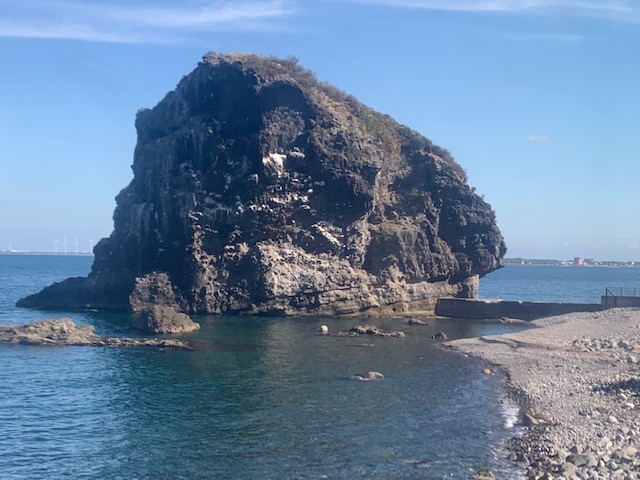
++++++++++++++
In 1865 Otaru was a small fishing village of 1000 people. Forty years later it was a booming port city. It owed its prosperity to the concentration of banks built to fund development at a time when Otaru was gateway to more remote parts of Hokkaido. At one time there were twenty-six sizeable banks, and one street had so many it was dubbed ‘the Wall St of Northern Japan’.
As well as banks. the area is full of old warehouses and historical shops. Helpful explanation boards explain the architectural significance and make the area a veritable outdoor museum. The design details are impressive. Pride of place goes to the National Bank of Japan, which was considered a wonder of its time, with ceilings so high that people made special journeys just to see them.
The Western buildings have a wonderful solidity, for the granite stone and Greek pillars were built to last. There is something reassuring about them, as if to say your money is safe – and appreciated! In the case of the Chamber of Commerce, stone was imported from Ishikawa Prefecture and marble from Shikoku. Many of the buildings combine a Western structure with Japanese touches, such that West here truly does meet East.
The development of Otaru was boosted by a railway line built in 1880 with the help of American engineers. The opening up of Hokkaido led to a huge volume of coal and agricultural products being shipped out to Honshu, and for roughly a century the line was kept busy. Now a short stretch of the disused track serves as ‘a Romantic walkway’, with flower boxes where couples pose for photos. It prompted Hirota and me to think of captions, such as ’On Track for Romance’ or in country music style, ‘Missed the Train, but I Found You’.
The whole charm of Otaru is captured in Sakaimachi-dori, a wonderful street with funky art and craft shops. Here you can browse displays of goods from artisan workshops, and there are cafes with the pleasant chinking of glass wind chimes. A shop named Kamuy, dedicated to Ainu go(o)ds, says for its sales pitch, ‘Fire, mountains, valleys, the ocean, animals, plants, even tools and clothing the Ainu make and use, all are Kamuy.’
We forget most of the time that we live in an enchanted world.
********************
Shinto rituals are carried out with absolute precision by priests, and their training manuals detail the correct manner of procedure including the exact place where to put one’s feet. Mistakes are deemed to be offensive to the kami. The exactitude is mirrored throughout the culture (the tea ceremony being an example), and can be seen even in daily life – like sushi restaurants.
A few minutes walk from the canal area lies ‘Sushi Street’, with reputedly the town’s best seafood. Seasonal delicacies include sea urchin and octopus in spring, salmon in summer, and herring in autumn. So abundant were the latter that the town boasted ‘herring millionaires’. Just how opulent was their lifestyle can be seen at the Old Aoyama Villa with its gorgeous fusuma paintings and decorated ceiling panels.
In the past the sea was said to be so full of fish that they leapt into fishermen’s arms. 90% of the catch was not even used as food – it was made into high quality fertiliser for such crops as cotton and indigo. Sadly the cornucopia was ruined by overfishing, and now with the warming of the sea fish stocks are in dangerous decline.
My friend Hirota san chose a restaurant for us, and we were ushered to the counter in front of which two impassive chefs were performing a form of ritualised theatre. Swaying gently side to side in white uniforms, they took a handful of moist rice with one hand, squeezed it into shape and with the other added a dash of wasabi. This was topped with a slice of fish, wrapped with a strip of nori, and finally placed very deliberately in an eye-pleasing arrangement on a decorated dish which was set before us. Meanwhile, hands took a dip in water and a wipe on a clean white cloth, then the whole process started again. This was synchronised sushi at its best.
The stylised, polished, perfectly timed theatrics reminded me of taiko performers, so well rehearsed that each movement is in absolute unison with others. Along with the precision was a concern with aesthetics. The dish for the sushi was decorated with a sasa leaf, which echoed the real one placed amongst the food, and an acorn on the sashimi plate added a seasonal touch. Most pleasing of all was a thin orange line painted on the little soy dish, which resembled the final flourish of a calligraphic masterstroke.
Imagine this for a meal – sushi portions of salmon, shrimp, tuna, squid, flying fish eggs, and Japanese flounder, served along with miso soup and six kappa sushi (small rolls of tuna with cucumber). All of it perfectly presented and followed by sorbet and coffee for just $15. Where else could you get aesthetics combined with mouth-watering nutrition at that price?
****************
Are Japanese a race apart? The mythology suggests as much, in that the country was created by the cosmic coupling of Izanagi and Izanami. Still today the Shinto establishment privileges Ise Jingu as home of the sun goddess, Ur-ancestor of the imperial line. The notion of being special is never far from the surface, as was seen during the recent pandemic…
At one point in the crisis Japanese abroad were allowed to return to Japan, but non-Japanese with permanent residency were not. It made no sense. Even after the restriction was lifted, different standards were applied. My friends might serve as example, for on arrival at Kansai Airport the French husband was taken aside to be tested, while his Japanese spouse was waved straight through. Could the virus distinguish between the two?
The issue brings up the whole matter of Japaneseness. There are basically two forms of nationality, one territorial (jus soli) and one based on blood (jus saguinis). The former privileges place of birth, the latter parentage. In this sense Japan is at the opposite end from the French model, which accepts immigrants but is resistant to outside culture. By contrast, Japan readily embraces foreign culture, but is resistant to immigrants. Take asylum seekers, for instance: in 2018 Japan accepted a total of 42, whereas France took in 20,710.
A letter to The Japan Times by a bemused American illustrates the ironies. A newcomer to Tokyo, he saw a bar called Manhattan displaying a large Stars and Stripes. Being from New York, he wanted to enter but was told in the nicest possible way that there was a ‘No Foreigners’ policy. ‘Maybe you can’t understand our customs,’ they told him. He quite genuinely couldn’t. Multiculturalism had run up against monoculturalism and was nonplussed.
Given the global nature of modern life, it is remarkable that Japan manages to retain such insularity. Nonetheless, change is happening, for ‘international marriages’ are on the increase and labour shortages necessitate acceptance of overseas workers. The change is most apparent in sports, with the national rugby team of 2019 including every possible gradation of Japaneseness from full-blooded to only one grandparent, and even naturalised Japanese.
Change is evident elsewhere too: Miss Japan 2015 was mixed race, born to a Japanese mother and an African-American father. Tennis star Naomi Osaka, chosen to light the torch at the Olympics opening ceremony in 2021, has a Haitian father and was raised in the US from the age of three. She was just one of thirty mixed race Olympians representing Japan, including judo gold medalist Aaron Wolf (American father), basketball player Rui Hachimura (Beninese father), Monica Ooye (Nigerian father) and Evelyn Mawuli (Ghanaian parents).
The result is that, almost by stealth, a new Japan is taking shape, Tokyo is home to over half a million foreigners, and in Shinjuku one person in eight was born overseas. Statistically, around 2% of babies have at least one foreign parent, and though the ‘one race, one nationality’ discourse remains influential, a younger generation will soon be speaking with a different kind of voice.

